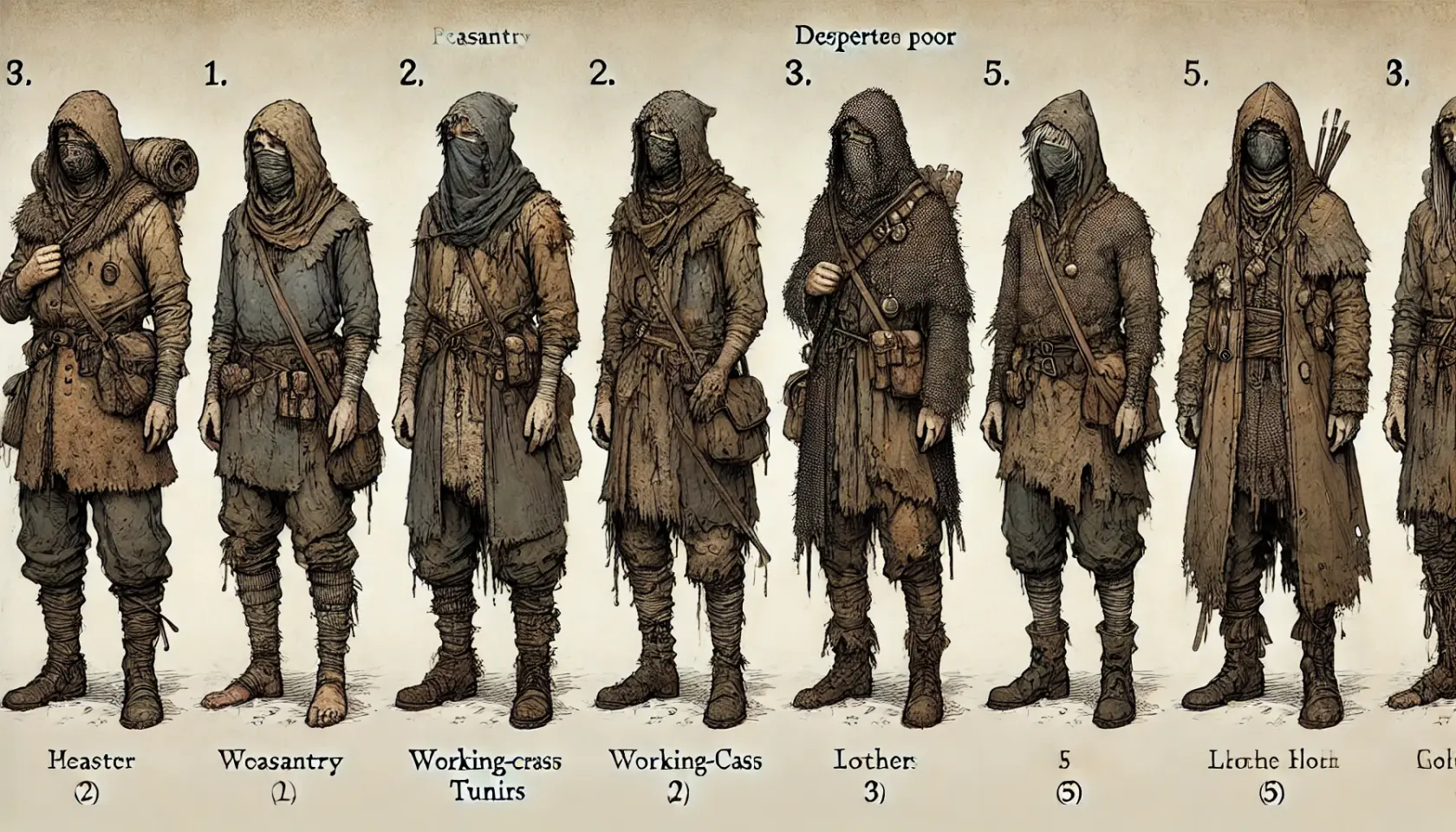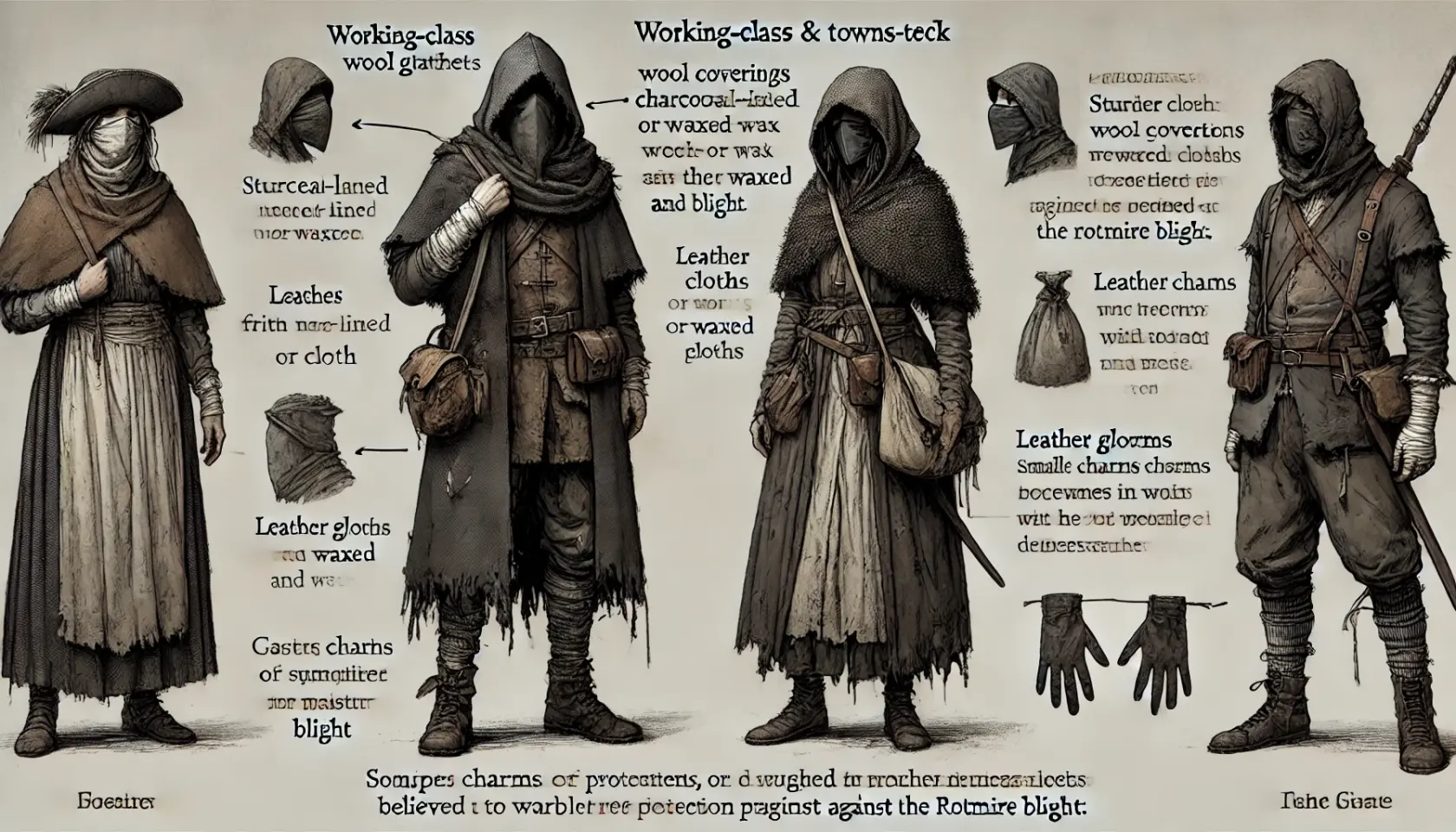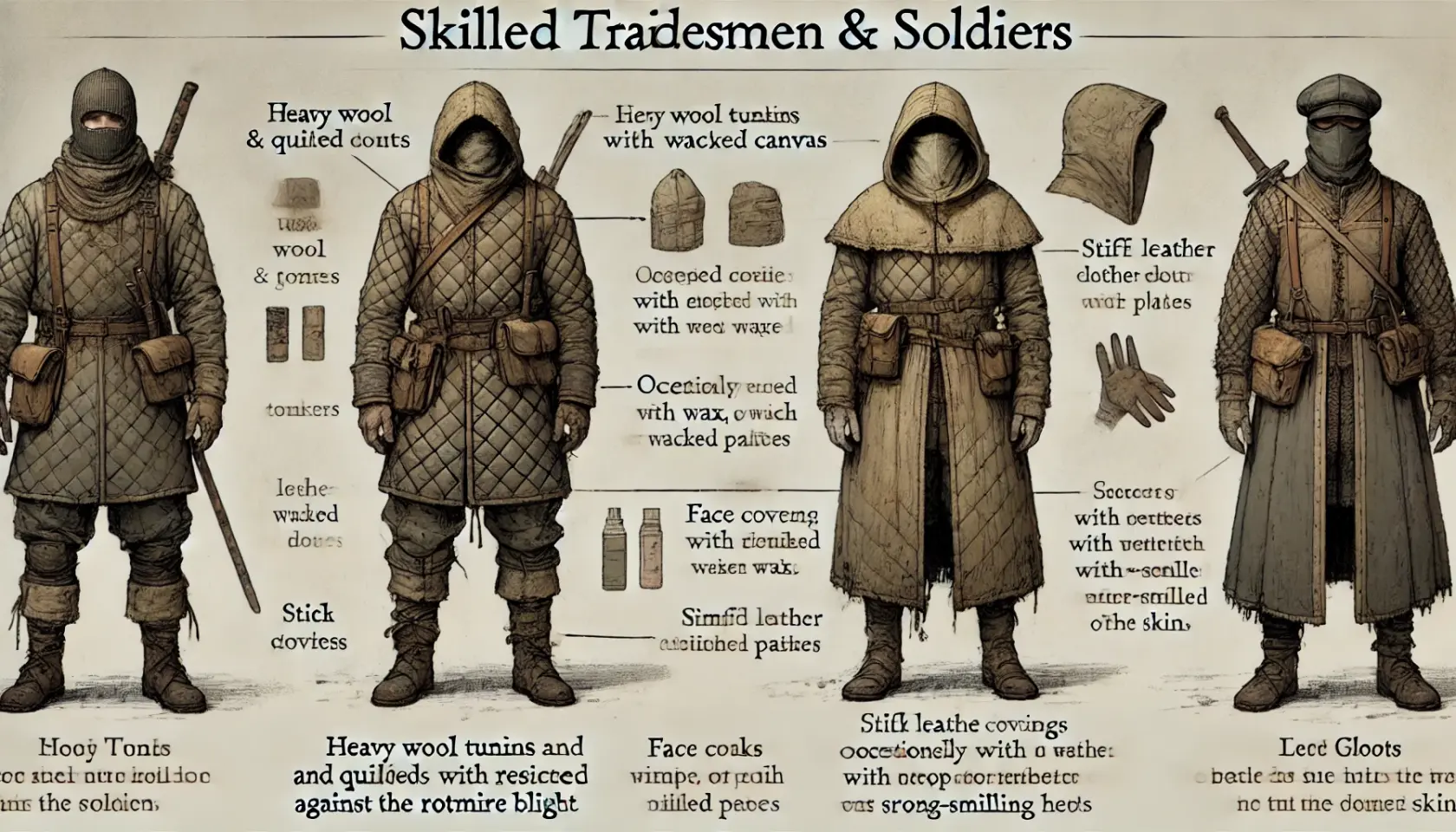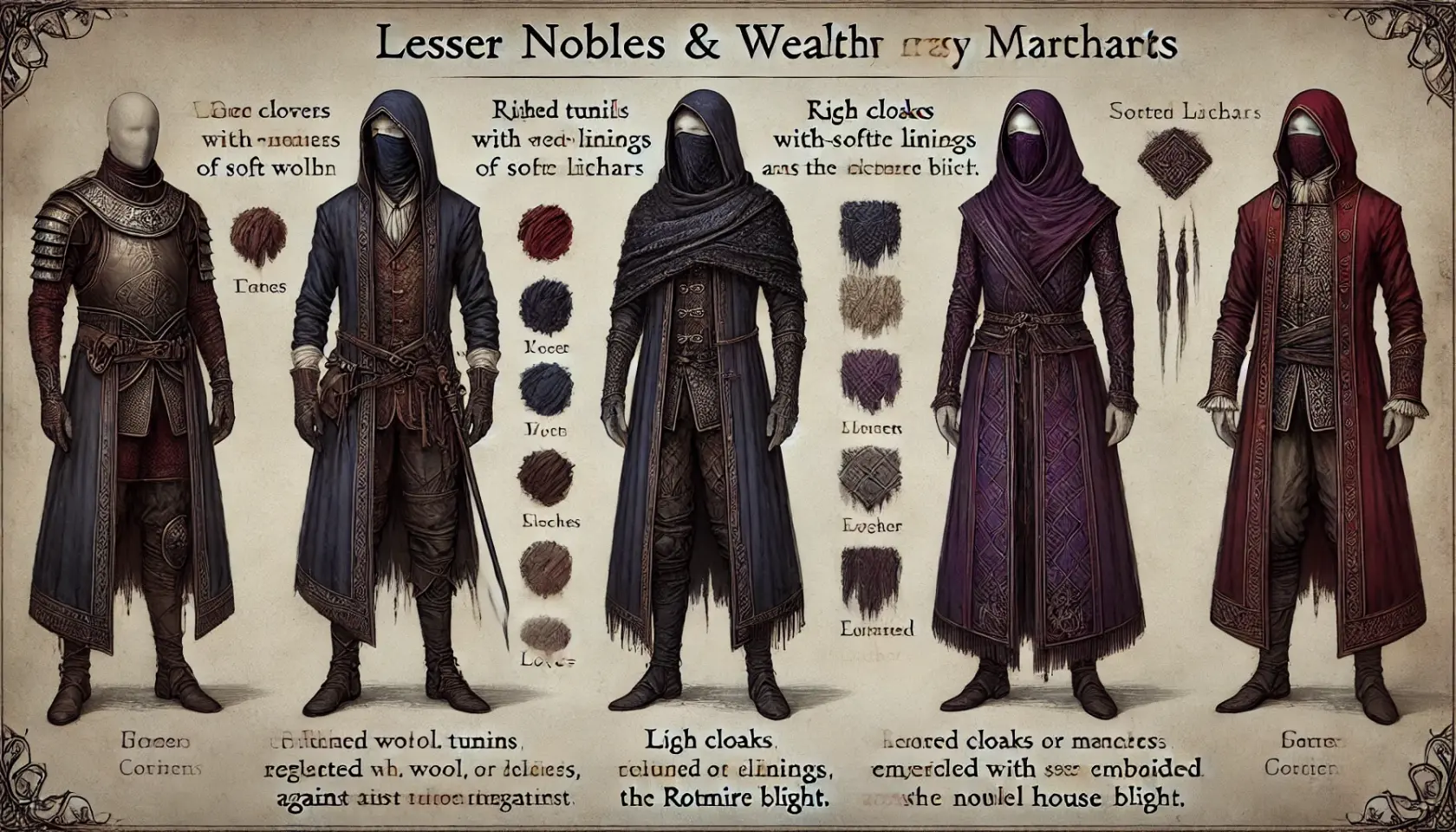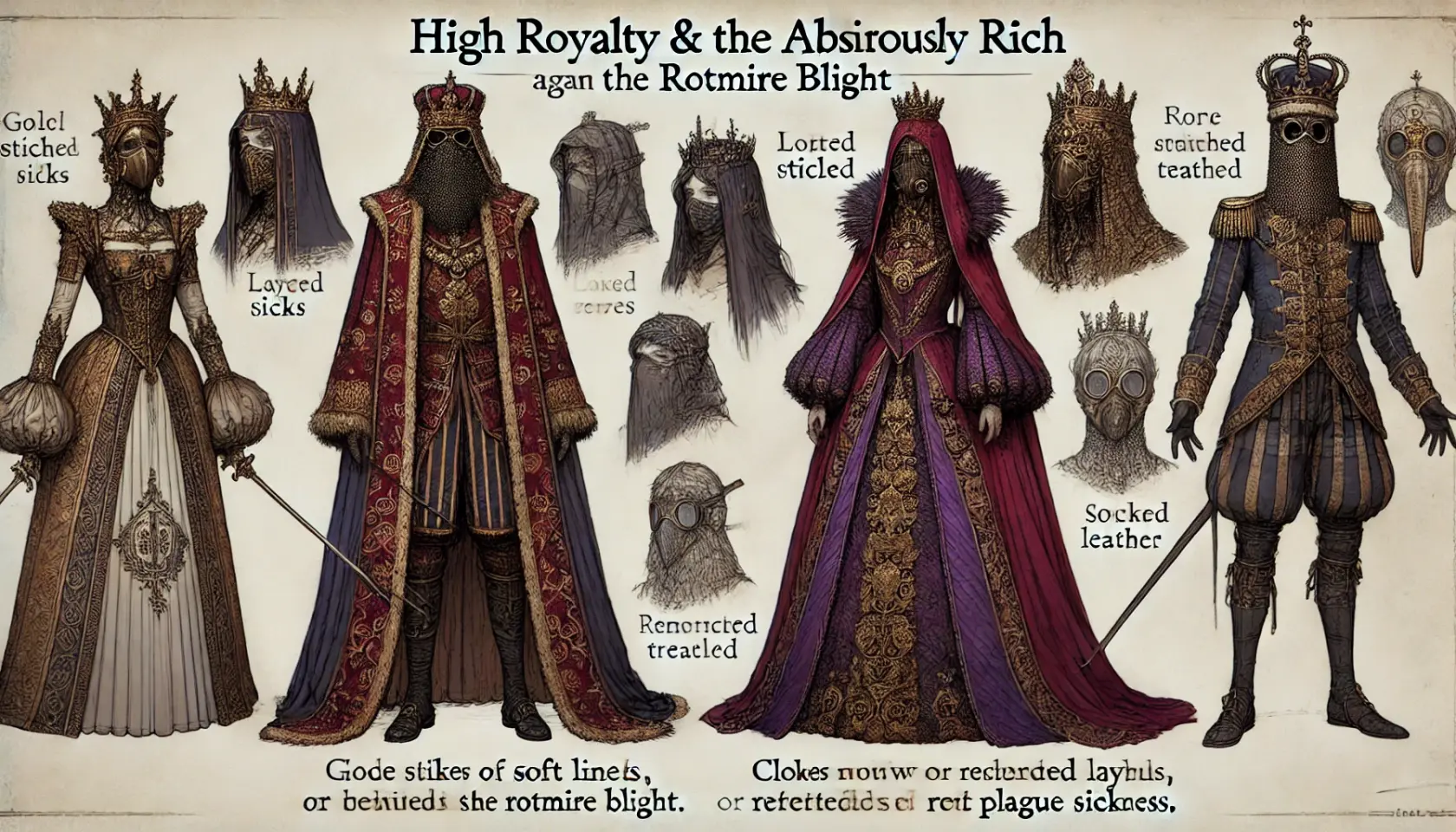Surviving the Blight
The spread of the Rotmire Blight has forced the people of Norvostra to adopt whatever means they can to avoid infection, yet the vast gulf between wealth and poverty dictates the effectiveness of these efforts. From the lowest peasant to the highest noble, each social tier has developed its own methods of protection, though some are far more effective than others.
The Desperate Poor & Peasantry
The lowest in society—the desperate poor and peasantry—have little to no resources and are left to rely on crude, often superstitious methods. Their clothing is a patchwork of ragged wool and linen, layered in hopes of creating some form of barrier between themselves and the tainted air.
Those who can afford to do so soak their scarves and rags in vinegar or animal fat, believing it blocks the pestilence from their lungs. Some smear mud or grease onto their skin, convinced that rot cannot cling to rot. They wrap their hands in old cloth strips or crude leather scraps and trudge through the streets barefoot or in rotting wooden clogs, their feet caked in filth.
Small charms—bits of bone, dried herbs, or even the corpses of small animals—are sewn into their clothes, acting as wards against the sickness. The poorest burn trash and animal dung in pits outside their homes, hoping that thick, choking smoke will drive away the unseen death in the air. Most among them, however, are doomed to succumb to the Blight, their lack of true protection ensuring a slow and miserable demise.
The Working Class & Struggling Townsfolk
Slightly above them, the working class fares only marginally better, able to afford simple protective measures that offer at least some resistance to the plague. Their clothing is still made of wool and linen but is sturdier and often treated with wax, oil, or pitch to repel airborne contaminants.
They wear cloaks with additional layers, often lined with scraps of charcoal-soaked cloth to filter the air. Their face coverings are more structured, made from thick linen wraps lined with dried herbs or alchemical tinctures meant to ward off disease.
Gloves of leather, sometimes dipped in wax or lye, protect their hands, while their boots—often patched and worn—are at least reinforced enough to keep their feet from direct contact with filth. These people carry satchels filled with medicinal herbs, vials of vinegar, or crude tonics they sip to ‘cleanse’ their insides.
They still cling to superstition, wearing talismans and sewing runes into their coats, but their methods have at least some basis in function. Though they still face grave danger, their precautions grant them a fighting chance.
The Skilled Tradesmen & Caravan Guards
Skilled tradesmen, caravan guards, and lower-ranking soldiers employ more practical and durable defenses, benefiting from better craftsmanship and access to basic alchemical treatments. Their clothing consists of quilted tunics reinforced with waxed canvas, making them more resistant to grime and contaminants.
Leather gloves, often reinforced with thin metal plates or padded with thick wool, protect their hands, while their boots are studded and layered for additional insulation. Face coverings become more sophisticated—while still cloth, they are treated with vinegar, charcoal, or even simple alchemical solutions, offering better filtration.
Many wear full hoods or wide-brimmed hats to further shield themselves from airborne rot. Some among them possess rudimentary amulets or relic fragments, believed to provide an extra layer of protection.
These individuals frequently burn strong-smelling herbs, wash with lye, and cleanse their equipment with fire, knowing that their survival depends on vigilance.
The Soldiers & Men-at-Arms
The professional soldiers and men-at-arms of noble houses wear even stronger defenses, though their concerns lie as much in warfare as they do in disease prevention. They don chainmail, breastplates, or scale armor over thick gambesons, providing both physical and environmental protection.
Their gloves are reinforced, their boots are hardened, and their cloaks—often waxed or treated with alchemical resins—offer additional layers of security. Unlike the lower classes, who wrap their faces in rags, these warriors cover their mouths with tightly fitted scarves or structured linen masks, sometimes with metal or leather reinforcements.
Their hoods and helmets are padded and sometimes incorporate protective neck guards. They carry belts lined with medicinal tinctures and emergency rations, knowing that isolation from the infected is key to survival.
Though they are trained to fight, their primary concern is keeping the plague at bay, and they follow strict regimens of cleansing and purification.
The Wealthy Merchants & Lesser Nobles
Among the wealthy merchants and lesser nobles, protection shifts from necessity to status. Their garments, while still functional, are of far higher quality, made of rich wool, velvet, and brocade. Deep, expensive colors—blues, purples, and burgundies—denote wealth, while their cloaks are lined with fine silks or embroidered linen.
These people wear gloves of soft leather, stitched with silver thread and scented with rare oils. Their face coverings, rather than crude rags, are layered silk scarves, embroidered with house insignias and filled with sachets of dried herbs or infused cloth.
High collars and decorative but functional hoods shield them from exposure, while their boots—polished and reinforced—keep them from direct contact with filth. Many wear elegant belts lined with alchemical vials and protective charms, each a symbol of both status and supposed immunity.
Though their practices are not entirely without merit, they place as much faith in prestige and relics as they do in actual protection.
The High Nobility & The Wealthy
At the very pinnacle of society, the high nobility and the absurdly rich exist in near-total seclusion, their fear of the Blight bordering on obsession. Their clothing is the most lavish, made from the finest silks, embroidered with gold and silver filigree, and infused with alchemical treatments meant to repel disease.
Cloaks of deep purple, midnight blue, and blood-red line their figures, trimmed with fur and sewn with protective sigils. Their gloves are of the softest lambskin, stitched with relic fragments and perfumed with scented oils believed to cleanse the air around them.
Their face coverings, far from simple cloths, are elaborate silk veils, half-masks, or wrapped fabrics embroidered with sacred patterns, some even soaked in rare herbal infusions. High collars, decorative mantles, and gilded overcoats ensure no part of their skin is left vulnerable.
Their boots, stitched with precious metals, are as much a display of wealth as they are a barrier against sickness. Around their necks and wrists hang relics, amulets, and alchemically infused gems, each one rumored to grant divine protection.
They move only within the safest parts of their palaces and estates, guarded by layers of quarantine. They live in gilded isolation, cocooned in wealth, yet no amount of luxury can erase the fear that lingers in their eyes.

